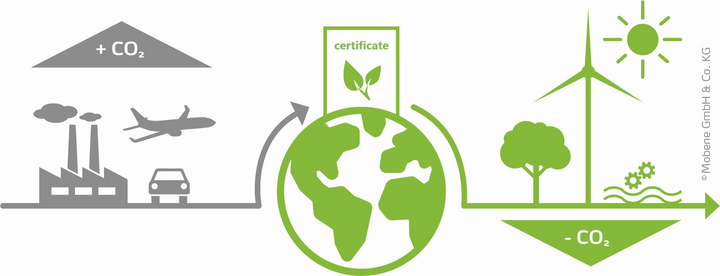How does offsetting work?
Climate offsetting should always be the last step towards more climate protection in aviation; the priority should always be to avoid flights wherever possible. However, if taking a flight cannot be avoided and the decision has been made to offset the emissions, the climate impact of the flight must first be quantified. Various online calculators are available for this purpose.
The calculated emissions are then offset with carbon offset credits, which can be purchased from various organizations. Two types of credits come into question:
1. Carbon offsets from climate protection projects
The revenue from the sale of carbon offsets is used to finance and implement a specific climate protection project. For this purpose, climate protection projects must first register with offset programs. These specify the requirements for climate protection projects and the issuing of offset credits. Independent experts verify whether a project meets the requirements of the offset program. After successful verification and registration, the emission reductions must be measured and calculated according to the set methods. A credit is then issued for each ton of CO₂ saved. Offset credits can be traded in electronic registries and sold to intermediaries or end customers. When the offset credits are used, they are deleted from the register. There is a large variety of climate protection projects, offset programs and sellers of carbon offset credits. The characteristics of these credits and their actual climate impact can differ considerably.

2. Allowances from emission trading systems
Under an emissions trading system, a cap is set on the maximum volume of greenhouse gas emissions permitted for a group of emitters. A credit is issued for each ton of CO₂ allowed. The emitters are allocated allowances or must purchase them from the government and provide proof of having a credit for each ton of their greenhouse gas emissions. Emissions trading systems are designed to meet climate targets as cost-effectively as possible. This is because those who can mitigate greenhouse gases at a lower price can bring about a larger emission reduction and sell surplus allowances to others for whom cutting emissions would cost more. Emissions trading systems were not originally designed for voluntary offsetting, but in principle institutions and individuals can purchase and then cancel allowances (for example via The Compensators). This diminishes the supply of allowances and thus reduces overall emissions. This is because the purchase of these credits indirectly increases the climate target of the emissions trading system. In practice, a number of aspects should be borne in mind, however. A positive environmental impact is only achieved if the total emissions permitted by the system are not set too high. Furthermore, some emissions trading systems have instruments to stabilize allowance prices. Under certain circumstances, these can mean that cancelling a credit only decreases the maximum total emissions by less than one ton of CO₂.